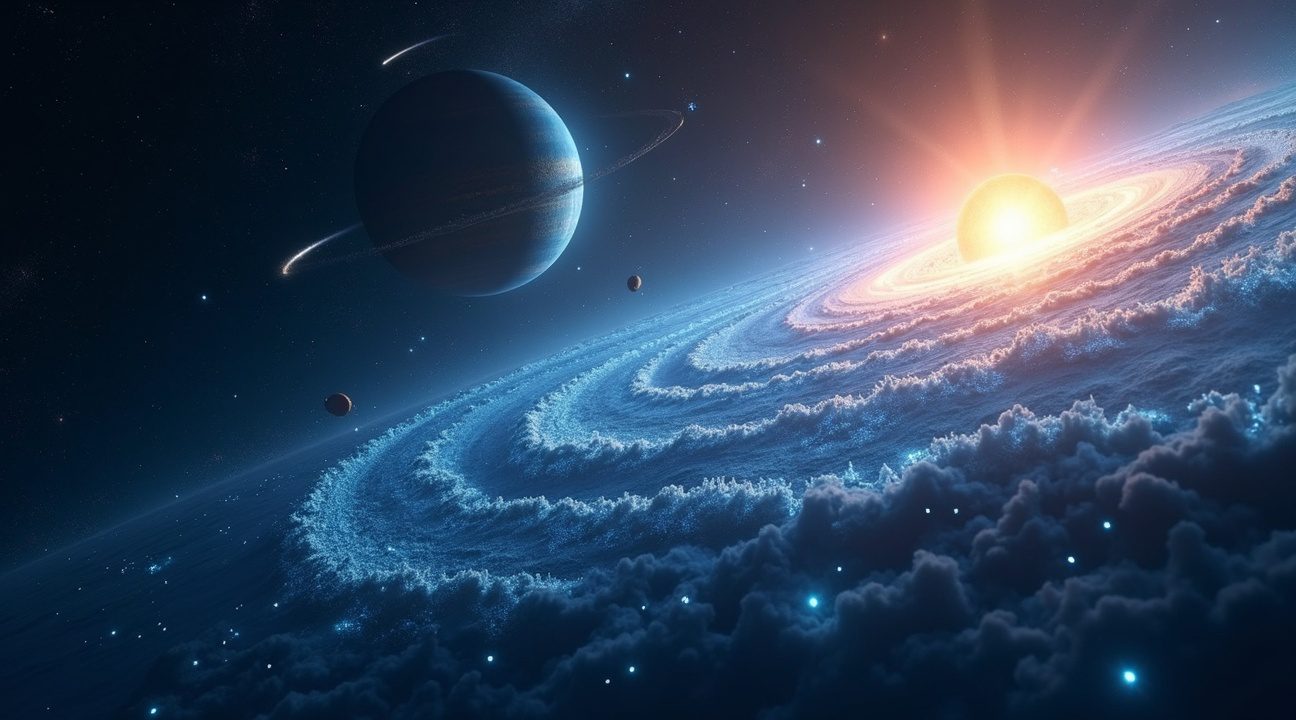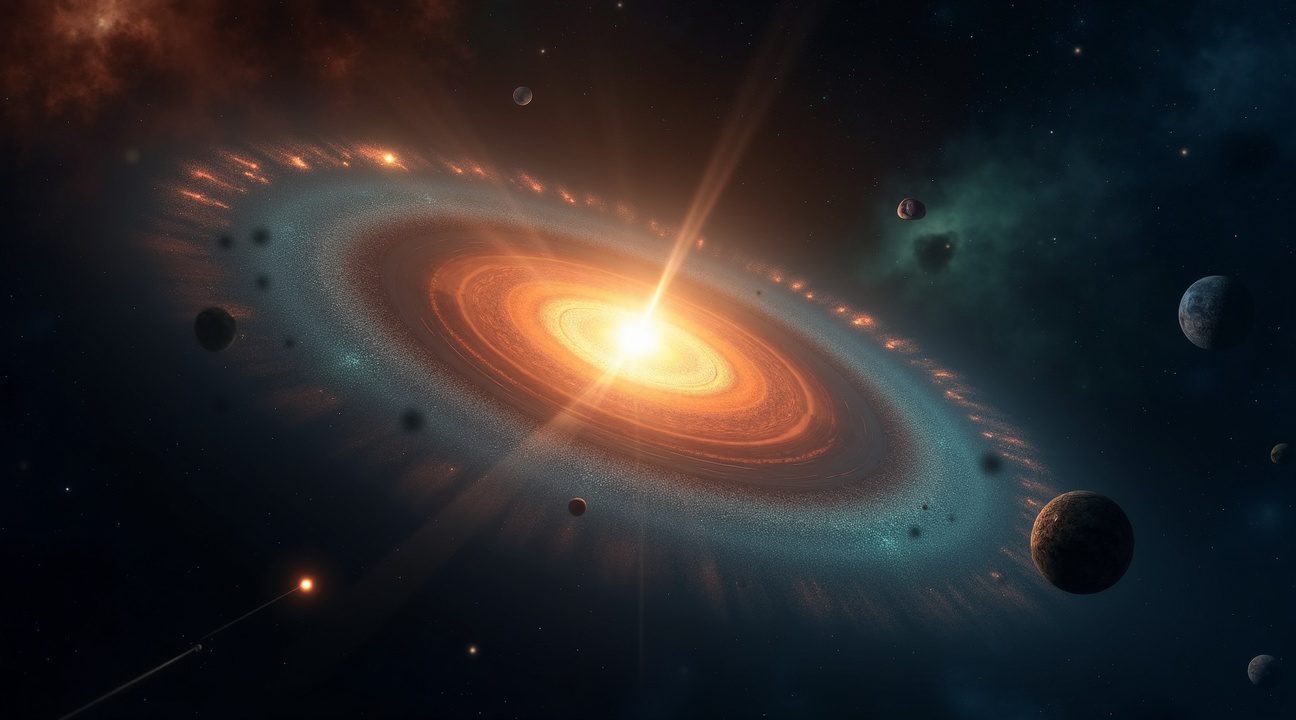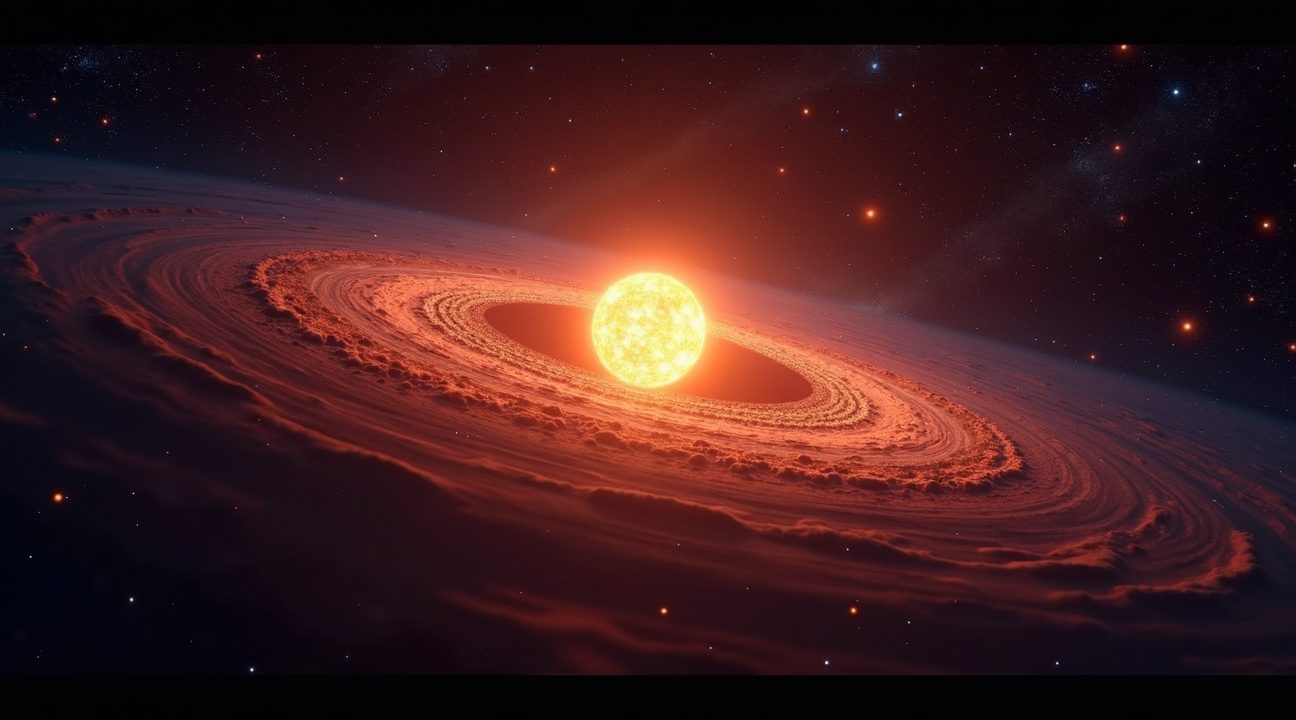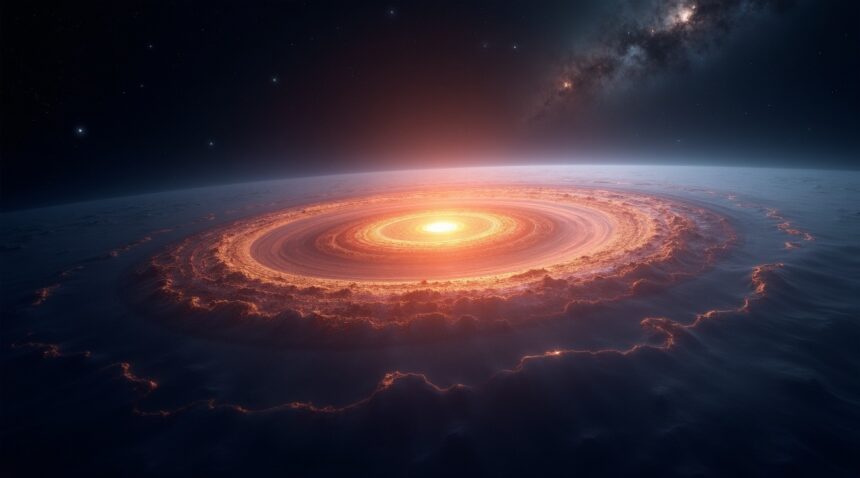Astronomers have reached a historic milestone by detecting doubly deuterated water (D₂O) in the planet-forming disk around the young star V883 Orionis, marking the first-ever discovery of heavy water in a protoplanetary disk. This remarkable water predates even the star itself, having originated billions of years ago in cold molecular clouds and surviving the turbulent formation of a new stellar system—all while retaining its chemical identity.
Key Takeaways
- Heavy water detected in V883 Orionis: This landmark discovery marks the first confirmed observation of D₂O in a protoplanetary disk, accomplished using the highly sensitive capabilities of the Atacama Large Millimeter/submillimeter Array (ALMA).
- Origins of deuterated water: The D₂O molecules identified in the disk are significantly older than the star they orbit, having formed in ancient molecular clouds long before the star’s birth and persevered through the intense processes of stellar formation.
- Implications for Earth’s oceans: This detection lends strong support to the theory that the water found on Earth may have interstellar origins, delivered here from outer space rather than emerging solely within the solar system.
- Deuterium as a cosmic time capsule: The unique isotopic fingerprint of deuterated water acts as a chemical tracer linking modern planetary environments to ancient cosmic events, supporting the idea of universal water inheritance across generations of star formation.
- Framework for astrobiology and planetary science: These findings help scientists better understand how essential ingredients for life, like water, are distributed and recycled throughout the galaxy, forming a foundational basis for future explorations into the origins of habitable worlds.
Ancient Heavy Water Discovered Orbiting Young Star for the First Time
Astronomers achieved a remarkable breakthrough by detecting doubly deuterated water (D2O) in a planet-forming disk around the young star V883 Orionis. This discovery marks the first-ever detection of heavy water in any protoplanetary disk, opening new avenues for understanding how water forms in emerging planetary systems.
The detection occurred using the powerful Atacama Large Millimeter/submillimeter Array (ALMA), which allowed scientists to peer into the disk surrounding V883 Orionis with unprecedented precision. Heavy water represents an exceptionally rare isotopic form of water where both hydrogen atoms have been replaced by deuterium, a heavier isotope of hydrogen. This substitution makes D2O roughly twice as heavy as regular water molecules.
The significance of this finding extends far beyond its rarity. Heavy water serves as a critical tracer for understanding the chemical processes that occurred during the early formation of our solar system. Since deuterium forms under specific conditions and temperatures, its presence in planet-forming disks provides valuable insights into the thermal and chemical environment where planets eventually emerge.
Implications for Planetary Formation Models
This groundbreaking discovery, reported in Nature Astronomy, challenges existing models of how water distributes itself throughout protoplanetary disks. Scientists can now use heavy water as a diagnostic tool to trace the movement and evolution of water molecules from the earliest stages of planetary system formation. The detection suggests that complex chemical processes begin much earlier than previously thought, potentially influencing the water content of planets that form within these disks.
The rarity of heavy water makes this detection particularly valuable for refining our understanding of isotopic ratios in forming solar systems. Deuterium forms primarily during specific nucleosynthetic processes, and its preservation in planet-forming environments indicates that certain chemical pathways remain active throughout disk evolution. This information helps scientists better predict where water-rich planets might form and how their chemical composition develops over time.
The V883 Orionis system now serves as a natural laboratory for studying water chemistry in its most primitive form. Future observations of similar systems may reveal whether heavy water detection becomes a common feature of planet-forming disks or remains an exceptional occurrence tied to specific stellar environments.
https://www.youtube.com/watch?v=yWj9P7pQ128
Water Older Than Its Own Star Challenges Formation Theories
The heavy water detected around V883 Ori carries a remarkable secret that fundamentally reshapes our understanding of how planetary systems form. This D2O didn’t originate within the star’s disk but instead represents ancient ice that formed billions of years ago in cold molecular clouds, long before the star itself existed.
Scientists have discovered that this deuterated water predates the birth of V883 Ori, creating a fascinating scenario where water molecules orbit a star they’re older than. The heavy water survived the violent process of stellar formation, maintaining its original composition despite the extreme conditions that accompanied the star’s birth and the subsequent development of its surrounding disk.
Margot Leemker, the study’s lead author, emphasized the profound implications of this finding: “The water seen in this planet-forming disk must be older than the central star and formed at the earliest stages of star and planet formation.” This statement confirms that water doesn’t always form locally within stellar systems but can be inherited from much earlier cosmic processes.
Chemical Fingerprints Reveal Ancient Origins
Heavy water’s distinctive isotopic signature functions as an unmistakable chemical fingerprint that proves its interstellar heritage. The specific ratio of deuterium to hydrogen in these molecules matches the composition found in primordial ices rather than water that would form within the disk itself. This chemical evidence definitively demonstrates that the water originated in interstellar space rather than through local formation processes.
The preservation of this ancient water through stellar formation represents an extraordinary survival story. During star birth, temperatures and pressures reach extreme levels that typically destroy or alter most molecular structures. However, these primordial ice grains managed to maintain their original isotopic composition, creating a direct link between present-day planet-forming regions and the ancient molecular clouds from which they emerged.
This discovery settles a long-standing scientific debate about water’s origins in stellar systems. Researchers had previously questioned whether water in planet-forming disks represented fresh material created during disk formation or ancient remnants from interstellar environments. The detection of heavy water with its preserved isotopic signature provides clear evidence that inheritance from ancient sources plays a crucial role.
The implications extend far beyond this single system. If water commonly survives stellar formation processes while retaining its primordial characteristics, then many planetary systems may contain water that connects them directly to the earliest stages of cosmic evolution. This inheritance mechanism suggests that the water eventually incorporated into planets carries a chemical history spanning billions of years.
The research team’s findings indicate that planet formation doesn’t occur in isolation but instead builds upon materials with deep cosmic histories. Water molecules that eventually become part of planetary atmospheres and oceans may have formed in molecular clouds long before their host stars ignited. This connection between ancient interstellar chemistry and modern planetary systems reveals how cosmic evolution operates across vast timescales.
Understanding this inheritance process helps explain why water appears so readily in many stellar systems. Rather than requiring each system to manufacture its own water supply, disks can draw upon vast reserves of ancient ice that have traveled through space for eons. This mechanism potentially accelerates the timeline for water availability during planet formation, creating more favorable conditions for the development of worlds capable of supporting liquid water.
The discovery also highlights the remarkable resilience of certain molecular structures across cosmic time. Despite experiencing the dramatic environmental changes associated with stellar birth, these ancient water molecules preserved their original isotopic fingerprints, allowing modern astronomers to trace their origins back to primordial molecular clouds. This preservation demonstrates how some aspects of cosmic chemistry can remain stable across billions of years of galactic evolution.
Revolutionary Evidence for Interstellar Water Continuity
The groundbreaking detection of heavy water in a planet-forming disk confirms a remarkable theory that has fascinated astronomers for decades: water molecules can survive the chaotic birth of stars and planetary systems. This discovery demonstrates that H2O isn’t destroyed and recreated during stellar formation but instead preserves its ancient chemical signature across billions of years.
Deuterium serves as nature’s time stamp, marking water’s journey through space. D2O forms preferentially in the frigid conditions of interstellar molecular clouds, where temperatures plummet to just a few degrees above absolute zero. These extreme conditions favor the incorporation of deuterium into water molecules, creating a distinctive isotopic fingerprint that scientists can track across cosmic distances and timescales.
The observation reveals that water molecules retain their deuterium-enriched signatures even as they experience the violent gravitational collapse that births new stars. Gas and dust swirl together at incredible speeds, generating temperatures hot enough to vaporize most materials, yet the deuterium ratios remain intact. This preservation mechanism explains how ancient molecular cloud chemistry connects directly to the formation of new planetary systems.
Implications for Planetary Water Origins
Scientists now possess concrete evidence that much of Earth’s water may have originated in primordial molecular clouds rather than forming locally within our solar system. The deuterium fingerprint found in the planet-forming disk matches signatures detected in:
- Comets from the outer solar system
- Meteorites that fell to Earth
- Water vapor in Earth’s oceans
- Ice found on other planetary bodies
This chemical continuity suggests that habitable worlds across the galaxy may share similar water origins. Planets forming around other stars could inherit the same deuterium-enriched water that eventually became Earth’s oceans, increasing the likelihood that water-rich environments exist throughout the cosmos.
The discovery fundamentally changes how astronomers understand planetary system formation. Rather than each star system creating its own unique chemical inventory, the findings reveal that molecular inheritance connects planetary environments across vast distances. Water molecules that condensed in ancient stellar nurseries now fill Earth’s oceans, having survived multiple cosmic recycling events.
Future observations of other planet-forming disks will test whether this water preservation occurs universally or represents a special circumstance. The deuterium tracking method provides researchers with a powerful tool to map water’s cosmic journey, potentially revealing which stellar environments best preserve the chemical building blocks necessary for life.

Earth’s Oceans May Have Galactic Origins
The groundbreaking detection of heavy water in V883 Ori’s planet-forming disk transforms our understanding of how Earth’s oceans formed. I observe that this discovery strengthens the compelling hypothesis that our planet’s water didn’t originate here at all. Instead, ancient ices and comets likely delivered these life-sustaining molecules from the depths of interstellar space, connecting Earth’s formation to a much larger galactic story.
The chemical fingerprints found in V883 Ori’s disk tell a remarkable tale. These signatures match almost perfectly with those discovered in comets within our own solar system, creating a direct bridge between distant star formation and our local cosmic neighborhood. This connection suggests that the same processes delivering water to forming planets around V883 Orionis once operated in our solar system billions of years ago.
Universal Water Delivery Systems
The implications extend far beyond our single star system. Scientists now recognize that the water delivery mechanism observed in V883 Ori likely represents a common process throughout the galaxy. This revelation carries profound consequences for understanding how habitable planets form across the universe:
- Similar chemical processes may operate in countless other star-forming regions
- Heavy water preservation in cold disk regions appears to be a standard feature of planetary system formation
- The transfer of water-rich materials from outer disk regions to inner planets may be a universal phenomenon
- Ancient interstellar ices serve as repositories for water that eventually reaches rocky planets
The presence of deuterium-rich water in these distant disks indicates that water-rich environments capable of supporting life may be far more common than scientists previously estimated. Each discovery of heavy water in planet-forming regions adds weight to the theory that life’s essential ingredients pervade the galaxy.
This finding repositions Earth within a broader galactic chemical context rather than viewing it as an isolated water-bearing world. The same interstellar processes that enriched V883 Ori’s disk with heavy water operated during our solar system’s formation approximately 4.6 billion years ago. Ancient comets and asteroids carrying this primordial water signature bombarded the early Earth, filling our oceans with molecules that originated in the cold depths of space.
The discovery fundamentally changes how I view the relationship between stellar nurseries and habitability. Water-rich planet formation appears to be an inherent feature of stellar evolution rather than a rare cosmic accident. The consistent presence of heavy water in these systems suggests that the building blocks for oceanic worlds exist wherever stars and planets form.
Understanding this galactic water cycle provides crucial insights into the potential for life beyond Earth. If the same chemical processes that delivered water to our planet operate throughout the galaxy, then countless other worlds may have received similar gifts from their stellar nurseries. The detection of heavy water in V883 Ori’s disk represents just one example of what may be a universal phenomenon.
This cosmic water story connects the formation of our oceans to events that occurred long before the solar system existed. Interstellar clouds enriched with heavy water collapsed to form new stars and planetary systems, carrying their chemical legacy forward through generations of cosmic evolution. Earth’s oceans thus represent the end result of galactic-scale chemical processes that have operated for billions of years.
The V883 Ori discovery provides the observational evidence needed to support this grand narrative of cosmic water delivery. Rather than requiring special circumstances or rare events, the formation of water-rich worlds appears to be a natural consequence of how planetary systems develop around young stars throughout the galaxy.
For further exploration, you can watch the coverage here:
https://www.youtube.com/watch?v=_wD6qRv6ZUI

ALMA’s Unprecedented Detection Capabilities
The Atacama Large Millimeter/submillimeter Array (ALMA) delivered the exceptional sensitivity needed to detect this elusive molecule in the V883 Orionis protoplanetary disk. This groundbreaking observation marks a significant milestone in astronomical detection technology and planetary formation research.
V883 Orionis: An Ideal Laboratory
V883 Orionis presents itself as a young, Sun-like star encircled by an actively planet-forming disk. This system serves as an ideal target for studying early planetary system chemistry because of its unique characteristics and accessibility to observation. The star’s properties closely mirror our own Sun during its formative years, providing valuable insights into how planetary systems like ours develop. Its planet-forming disk remains active and chemically rich, offering scientists a real-time view of the processes that shape new worlds.
Advanced Technology Enables Breakthrough
ALMA’s sophisticated millimeter and submillimeter wavelength capabilities proved essential for identifying the specific spectral signature of doubly deuterated water. I can observe how this detection required unprecedented precision in wavelength analysis and signal processing. The array’s multiple antennas work together to create an interferometric system that achieves remarkable resolution and sensitivity.
Several key technological factors made this detection possible:
- ALMA’s ability to operate across multiple frequency bands simultaneously
- Advanced receivers capable of detecting extremely faint molecular signatures
- Sophisticated data processing algorithms that can isolate specific spectral lines
- The array’s high angular resolution for pinpointing molecular locations within the disk
- Extended observation times that allow for signal accumulation and noise reduction
This technological achievement opens exciting new possibilities for detecting heavy water and other rare molecules in additional planet-forming systems. Scientists can now systematically search for deuterated water across various stellar environments and disk conditions. The success with V883 Orionis demonstrates that similar detections are feasible in other protoplanetary disks, potentially revealing how common or rare these deuteration processes are across different stellar systems.
The implications extend beyond heavy water detection alone. ALMA’s proven capability to identify such rare molecular species suggests that other complex organic molecules and isotopic variants may also be detectable in planet-forming environments. This advancement positions astronomers to conduct comprehensive chemical surveys of protoplanetary disks, building a detailed understanding of the molecular inventory available for planet formation across diverse stellar systems.

Cosmic Implications for Planetary Formation
The detection of heavy water in the IRS 63 protoplanetary disk fundamentally reshapes how astronomers view planetary formation across the galaxy. This discovery reveals that individual solar systems don’t exist in isolation but participate in a continuous galactic water cycle that has operated for billions of years. Water molecules, including their deuterated forms, pass from one generation of stars to the next, carrying with them the chemical signatures of cosmic history.
Understanding Galactic Water Distribution
Future research efforts can now systematically search for D2O in other protoplanetary disks throughout the galaxy. Scientists expect this ancient water inheritance process occurs commonly across different stellar environments, though confirmation requires additional observations. The research team, led by Margot Leemker and John Tobin, has established detection methods that other astronomers can replicate using the Atacama Large Millimeter/submillimeter Array and similar facilities.
Each new detection will build a comprehensive map of how deuterated water spreads through galactic neighborhoods. Some regions may preserve higher concentrations of ancient water than others, depending on their stellar formation history and local conditions. These variations could influence which planetary systems develop the chemical foundations necessary for life.
Framework for Life’s Building Blocks
The findings published in Nature Astronomy provide scientists with a new theoretical framework for tracking life’s essential ingredients across cosmic time scales. Heavy water serves as a tracer molecule that reveals the journey of water from interstellar clouds through multiple generations of star formation. This process ensures that planets forming today inherit water molecules that originated in the early universe.
The research demonstrates how chemical complexity builds up over billions of years rather than starting fresh with each new planetary system. Deuterated water concentrations in forming planets may correlate with their potential for developing habitable conditions. Systems that inherit higher amounts of ancient water could possess more diverse chemical inventories from the start.
This breakthrough changes how scientists approach the search for potentially habitable worlds. Rather than viewing each planetary system as an independent experiment in chemistry, astronomers can now consider how galactic-scale processes influence the distribution of life’s building blocks. The deuterium-to-hydrogen ratio becomes a cosmic clock that reveals the age and origin of water in any given system.
The implications extend beyond water alone. If heavy water survives the violent processes of stellar birth and planetary formation, other complex molecules likely follow similar preservation patterns. Organic compounds, amino acid precursors, and other biochemically relevant materials may also pass between stellar generations through this cosmic inheritance mechanism.
Understanding this process helps explain why some regions of the galaxy appear more chemically rich than others. Areas with longer histories of star formation accumulate more processed materials over time, creating environments where planets can access diverse chemical resources. These insights guide future surveys for potentially habitable worlds by identifying galactic regions most likely to host chemically complex planetary systems.
The discovery establishes deuterated water as a fundamental marker for studying planetary formation across different cosmic environments. As observational technology improves, astronomers will track these ancient water signatures in increasingly distant and diverse stellar systems. Each detection adds another piece to the puzzle of how life’s essential ingredients spread throughout the universe.
Sources:
Phys.org – First-ever detection of heavy water in planet-forming disk
SpaceDaily – Ancient Heavy Water Found in Planet-Forming Disk Reveals Solar Origins of Earth’s Oceans
Universe Today – Heavy Water Discovered in Protoplanetary Disk for the First Time
Orbital Today – Astronomers Found Ancient Heavy Water in Planet-forming Disk Older than the Sun
Nature – s41550-024-02397-z


